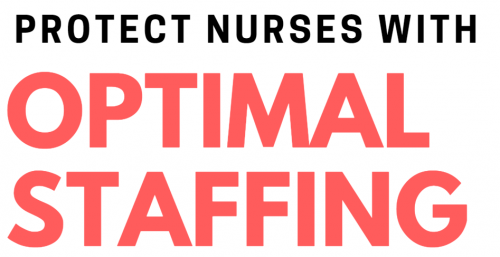Healthy Nurse, Healthy Nation™ Blog - Protect Nurses With Optimal Staffing
Published
ANA’s Senior Policy Advisor, Sharon Morgan, explains the impact staffing has on nurse and patient safety.
 Optimal nurse staffing and patient safety go hand in hand. “Without adequate staff, there is no patient safety or patient wellness,” says Sharon Morgan, MSN, RN, NP-C, and ANA’s Senior Policy Advisor. Understaffed nursing units compromise patient care and the issue may even cause nurses to leave the profession. “According to a 2011 study, when RN shift levels were below target for greater than 8 hours, risk of death increased by 2%,” says Morgan.
Optimal nurse staffing and patient safety go hand in hand. “Without adequate staff, there is no patient safety or patient wellness,” says Sharon Morgan, MSN, RN, NP-C, and ANA’s Senior Policy Advisor. Understaffed nursing units compromise patient care and the issue may even cause nurses to leave the profession. “According to a 2011 study, when RN shift levels were below target for greater than 8 hours, risk of death increased by 2%,” says Morgan.Insufficient nurse staffing accounts for:
- Higher rates of patient falls
- An increase in preventable infections
- Medication errors
- Increases in nurse burnout and dissatisfaction
On the flip side, appropriate staffing has been linked to a decrease in patient mortality and risk of death.
Is there a magic number of staff?
Sadly, no. Every nursing unit is different – an intensive care unit at an urban-level Trauma One center is not the same as an ICU in rural Iowa, for example. Plus, no two patients and nurses are alike. “Staffing levels have to include the skill mix of the nurses involved and the other ancillary staff on the floor. It also has to account for the acuity of the patient population,” explains Morgan.
Most nurse safety advocates agree we need to get better at tracking nurses’ contributions. “From a legislative point of view, we need more transparency and keener metrics to quantify the nurse value for an individual patient. The metrics that have been used over time are too rigid and don't address complex situations,” says Morgan.
It’s about the bottom line
Because there’s no standardized data to quantify nurse value, hospitals find it easier to cut the budget for nurses. “Nursing is rolled into hospital room and board. And since the metrics that could indicate the value of nursing isn't there, it's easy for administrators to cut nurses out of the budget without understanding the impact that has on patients,” says Morgan.
Inadequate staffing puts nurses at risk, too
Not only does poor staffing hurt patients, but it also causes nurses to suffer. The Institute of Medicine recommends that registered nurses should not exceed 12 hours of work in a 24-hour period, or 60 hours of work within seven days. ANA recommends that registered nurses not exceed 40 hours of professional nursing work in a seven-day period. “Research shows that working more than 40 hours a week starts putting patients and themselves at risk,” says Morgan.
According to ANA’s 2013-2016 Health Risk Appraisal, more than half of nurses regularly work shifts longer than 10 hours, yet research suggests the chance of a nurse making mistakes increases with hours worked. If nurses do work 12-hour shifts, they shouldn’t work more than three days in a row, which would be less than ANA’s recommendation of 40 hours per week.
For more on nurse fatigue, read ANA’s Addressing Nurse Fatigue to Promote Safety and Health: Joint Responsibilities of Registered Nurses and Employers to Reduce Risks.
How nurses can help
If you recognize staffing is a safety issue at your workplace, Morgan recommends the following:
- Find out who makes staffing decisions.
- Take your concern up the chain of command. Talk to your unit supervisor and ask how staffing is determined.
- Ask your supervisor how you can participate in staffing decisions.
- Review ANA's Nurse Staffing webpages to educate yourself more on the issue.
“Health care unfortunately is a business and if we don’t change that direction or put the fiscal value of the nurse to the forefront, nurses are going to continue to be the sacrificial lamb in the budget wars,” says Morgan.
Are there safe staffing practices at your workplace? Tell us in our staffing discussion or on Facebook.
Find this article helpful? Share it on Facebook, Twitter, or Instagram by clicking the icons to the left – and tell your supervisors staffing matters!
 Have you joined the Healthy Nurse, Healthy Nation (HNHN) Grand Challenge yet? Join us today!
Have you joined the Healthy Nurse, Healthy Nation (HNHN) Grand Challenge yet? Join us today! Reviewed and updated 12/5/22.
Source List:
Optimal Nurse Staffing to Improve Quality of Care and Patient Outcomes. ANA White Paper. (2015, September). (Editor's Note: Link updated 12/5/22 with Executive Summary).
Executive Summary: American Nurses Association Health Risk Appraisal (HRA). (2016, October). (Editor's Note: as of 12/5/22, this link is no longer available).
Stimpfel, A. W., Sloane, D. M., & Aiken, L. H. (2012, November). The Longer the Shifts for Hospital Nurses, the Higher the Levels of Burnout and Patient Dissatisfaction.
Blog Safety
10/27/2017 4:05pm CDT



Post a Comment or Question